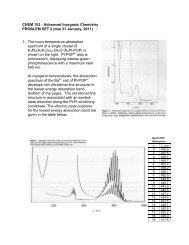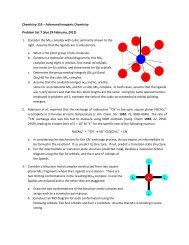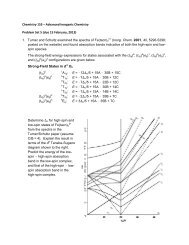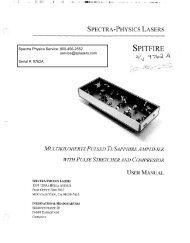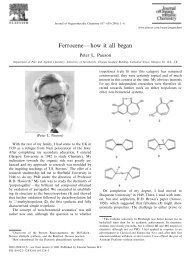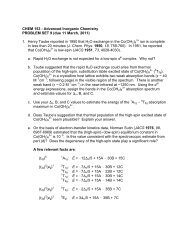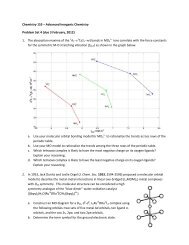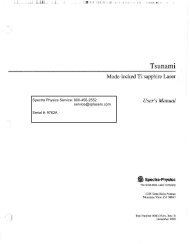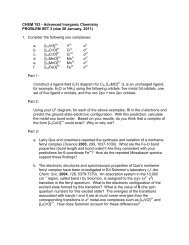NESLAB System III ystem III
NESLAB System III ystem III
NESLAB System III ystem III
You also want an ePaper? Increase the reach of your titles
YUMPU automatically turns print PDFs into web optimized ePapers that Google loves.
<strong>NESLAB</strong><br />
<strong>S<strong>ystem</strong></strong> <strong>III</strong><br />
Heat Exchanger<br />
Thermo Manual P/N U00678 Rev. 08/19/05<br />
Installation-Operation-<br />
Basic Service<br />
Visit our Web site at:<br />
http://www.thermo.com/tc<br />
Product Service Information, Applications<br />
Notes, MSDS Forms, e-mail.<br />
Voice Info: (800) 258-0830
Thermo Electron Corporation<br />
Control Technologies<br />
25 Nimble Hill Road<br />
Newington, NH 03801<br />
(800) 258-0830 or<br />
(603) 436-9444<br />
Fax : (603) 436-8411<br />
Netherlands<br />
Takkebijsters 1<br />
Breda 4817 BL<br />
Netherlands<br />
Tel : +31 76 587 9888<br />
Fax : +31 76 579 5610<br />
Control Technologies<br />
Main Service Center<br />
The Main Service Center is open<br />
8:00 am to 5:00 pm (Eastern<br />
Time), Monday through Friday.<br />
Thermo <strong>NESLAB</strong><br />
25 Nimble Hill Road<br />
Newington, NH 03801<br />
(800) 258-0830 or<br />
(603) 436-9444<br />
Fax : (603) 436-8411<br />
Germany<br />
Dieselstrasse 4<br />
Karlsruhe 76227<br />
Germany<br />
Tel : +49 (0) 721 4094 0<br />
Fax : +49 (0) 721 4094 300<br />
West Coast<br />
355 River Oaks Parkway, Door 10<br />
San Jose, CA 95134<br />
United States<br />
Tel : (800) 423-7831 or<br />
(408) 965-6050<br />
Fax : (408) 965-6051<br />
France<br />
16 Avenue du Québec - Silic 765<br />
Courtaboeuf Cédex 91963<br />
France<br />
Tel : 33 (0) 1 60 92 48 00<br />
Fax : 33 (0) 1 60 92 49 00<br />
South<br />
8711 Burnet Road<br />
Suite F69<br />
Austin, TX 78757-7065<br />
(512) 459-2167<br />
Fax : (512) 459-1731<br />
United Kingdom<br />
Ion Path, Road Three<br />
Winsford CW7 3GA<br />
United Kingdom<br />
Tel : +44 1606 548749<br />
Fax : +44 1606 548712<br />
© 2005 Thermo Electron Corp. 623-2087<br />
All rights reserved. This document is for informational purposes only and is<br />
subject to change without notice.
<strong>S<strong>ystem</strong></strong> <strong>III</strong> Liquid to Liquid Heat Exchanger<br />
Instruction and Operation Manual<br />
Table of Contents<br />
PREFACE<br />
SECTION I<br />
Safety<br />
SECTION II<br />
General Information<br />
SECTION <strong>III</strong><br />
Installation<br />
SECTION IV<br />
Operation<br />
Compliance ............................................................................................ 3<br />
WEEE Compliance ................................................................................. 3<br />
Unpacking .............................................................................................. 4<br />
Warranty................................................................................................. 4<br />
NES-care ................................................................................................ 4<br />
After-sale Support ................................................................................... 4<br />
Feedback ............................................................................................... 4<br />
Warnings ................................................................................................ 5<br />
Description ............................................................................................. 6<br />
Specifications ......................................................................................... 6<br />
Site......................................................................................................... 8<br />
Facility Water Requirements................................................................... 8<br />
Electrical Requirements .......................................................................... 9<br />
Voltage Selection ................................................................................... 9<br />
Plumbing Requirements .......................................................................... 9<br />
Fluids ..................................................................................................... 10<br />
Filling Requirements ............................................................................... 11<br />
Automatic Refill Device (Optional) ........................................................... 11<br />
Flow Control ........................................................................................... 11<br />
Auto Restart ........................................................................................... 11<br />
Start Up .................................................................................................. 12<br />
Temperature Controller ............................................................................ 13<br />
Setup Loop ............................................................................................. 14<br />
- 1 -
SECTION V<br />
Maintenance& Service<br />
SECTION VI<br />
Troubleshooting<br />
SECTION VII<br />
Diagrams<br />
APPENDIX<br />
Service Contracts ................................................................................... 15<br />
Pump Strainer ........................................................................................ 15<br />
Facility Water Strainer ............................................................................ 15<br />
Algae ...................................................................................................... 16<br />
Configuration ........................................................................................... 16<br />
Voltage Selection ................................................................................... 16<br />
Pressure Relief Valve .............................................................................. 16<br />
Fault Interlock Contact ............................................................................ 17<br />
Fuses ..................................................................................................... 17<br />
Phase Rotation ....................................................................................... 17<br />
Pump Motor Overload Protector .............................................................. 17<br />
Displaying Software Version ................................................................... 18<br />
Error Codes ............................................................................................ 19<br />
Poor Temperature Stability ..................................................................... 20<br />
Service Assistance ................................................................................. 20<br />
Parts List ................................................................................................ 20<br />
TU Pump Flow Diagram .......................................................................... 21<br />
Front View .............................................................................................. 22<br />
Rear View ............................................................................................... 22<br />
Large Volume Units ................................................................................ 23<br />
Water Quality and Standards<br />
WARRANTY<br />
- 2 -
Compliance<br />
Preface<br />
Products tested and found to be in compliance with the requirements defined in the EMC<br />
standards defined by 89/336/EEC as well as Low Voltage Directive (LVD) 73/23/EEC can be<br />
identified by the CE label on the rear of the unit. The testing has demonstrated compliance with<br />
the following directives:<br />
LVD, 73/23/EEC Complies with UL 3101-1:93<br />
EMC, 89/336/EEC<br />
EN 55011, Class A Verification<br />
EN 50082-1:1992<br />
IEC 1000-4-2:1995<br />
IEC 1000-4-3:1994<br />
IEC 1000-4-4:1995<br />
For any additional information refer to the Letter of Compliance that shipped with the unit<br />
(Declaration of Conformity).<br />
WEEE Compliance<br />
This product is required to comply with the European Union’s Waste Electrical & Electronic<br />
Equipment (WEEE) Directive 2002/96/EC. It is marked with the following symbol:<br />
Thermo Electron has contracted with one or more recycling/disposal companies in each EU<br />
Member State, and this product should be disposed of or recycled through them. Further<br />
information on Thermo Electron’s compliance with these Directives, the recyclers in your<br />
country, and information on Thermo Electron products which may assist the detection of<br />
substances subject to the RoHS Directive are available at:<br />
www.thermo.com/WEEERoHS<br />
- 3 -
After-sale Support<br />
Thermo Electron Corporation is committed to customer service both during and after the sale. If<br />
you have questions concerning the operation of your unit, contact our Sales Department. If your<br />
unit fails to operate properly, or if you have questions concerning spare parts, contact our<br />
Customer Service Department. Before calling, please obtain the following information:<br />
- BOM number<br />
- Serial number<br />
- Software version<br />
The BOM and serial number are on a label on the rear of the unit. To display the software<br />
version see page 17.<br />
Unpacking<br />
Warranty<br />
Retain all cartons and packing material until the unit is operated and found to be in good<br />
condition. If the unit shows external or internal damage contact the transportation company and<br />
file a damage claim. Under ICC regulations, this is your responsibility.<br />
Units have a warranty against defective parts and workmanship for one full year from date of<br />
shipment. See back page for more details.<br />
NES-care Extended<br />
Warranty Contract<br />
• Extend parts and labor coverage for an additional year.<br />
• Worry-free operation.<br />
• Control service costs.<br />
• Eliminate the need to generate repair orders.<br />
• No unexpected repair costs.<br />
Other contract options are available. Please contact Thermo us for more information.<br />
Feedback<br />
We appreciate any feedback you can give us on this manual. Please e-mail us at<br />
neslabmanuals@thermo.com. Be sure to include the manual part number and the revision date<br />
listed on the front cover.<br />
- 4 -
Section I Safety<br />
Warnings<br />
Make sure you read and understand all instructions and safety precautions<br />
listed in this manual before installing or operating your unit. If you have any<br />
questions concerning the operation of your unit or the information in this<br />
manual, contact our Sales Department.<br />
Performance of installation, operation, or maintenance procedures<br />
other than those described in this manual may result in a hazardous<br />
situation and may void the manufacturer's warranty.<br />
Observe all warning labels.<br />
Never remove warning labels.<br />
Never operate damaged or leaking equipment.<br />
Always turn off the unit and disconnect the line cord from the power<br />
source before performing any service or maintenance procedures, or<br />
before moving the unit.<br />
Always empty the reservoir before moving the unit.<br />
Never operate equipment with damaged line cords.<br />
Never operate without fluid.<br />
Refer service and repairs to a qualified technician.<br />
In addition to the safety warnings listed above, warnings are posted throughout<br />
the manual. These warnings are designated by an exclamation mark inside an<br />
equilateral triangle with text highlighted in bold print. Read and follow these<br />
important instructions. Failure to observe these instructions can result in<br />
permanent damage to the unit, significant property damage, or personal injury<br />
or death.<br />
- 5 -
Section II General Information<br />
Description<br />
The <strong>NESLAB</strong> <strong>S<strong>ystem</strong></strong> <strong>III</strong> Liquid to Liquid Heat Exchanger is designed to<br />
remove heat from water-cooled instruments. The unit consists of a heat<br />
exchanger, recirculation pump, PVC reservoir, and a microprocessor controller.<br />
Specifications<br />
Temperature Range<br />
Temperature Stability<br />
Cooling Capacity 1<br />
70<br />
+5°C to +40°C<br />
±1.0°C<br />
Pressure Drop (PSI)<br />
1 2 2.4 3.5 5 6 8 10<br />
60<br />
Heat Removal (KW)<br />
50<br />
40<br />
30<br />
A<br />
B<br />
C<br />
20<br />
10<br />
A= 6gpm pump flow<br />
B= 10 gpm pump flow<br />
C= 12gpm pump flow<br />
5 10 15 20 25<br />
Facility Water Flow GPM<br />
Reservoir Volume 2<br />
Gallons<br />
Liters<br />
Dimensions 3<br />
(H x W x D)<br />
Inches<br />
Centimeters<br />
Shipping Weight 4<br />
Pounds<br />
Kilograms<br />
1.25<br />
4.7<br />
20¾ x 17 3 /8 x 27<br />
52.7 x 44.1 x 68.6<br />
206<br />
93.4<br />
1. Cooling capacity is based in a 10°C difference between the temperature of the cooling<br />
water<br />
supply and the cooling fluid flowing from the <strong>S<strong>ystem</strong></strong> <strong>III</strong><br />
to the instrument being cooled (see<br />
Section <strong>III</strong>, Facility Water Requirements). Pressure drop obtained with the <strong>S<strong>ystem</strong></strong> <strong>III</strong> modulating<br />
valve fully open.<br />
2. Larger volume reservoir units are available.<br />
3. Units with CP-55 and TU-3 pumps. Other larger volume units measure 33¾ x 23 x 27¼<br />
(85.7 x 58.4 x 69.2). For complete dimensions see pages 22-23.<br />
4. Approximate. Larger volume units weigh approximately 355 pounds (161 kilograms).<br />
- 6 -
Pump Capacity 5,6<br />
70<br />
60<br />
50<br />
A<br />
Pressure (psi)<br />
40<br />
30<br />
20<br />
10<br />
D<br />
C<br />
B<br />
E<br />
F<br />
A=TU-7, 60Hz<br />
B=TU-7, 50Hz<br />
C=TU-3, 60Hz<br />
D=TU-3, 50Hz<br />
E=CP-55, 60Hz<br />
F=CP-55, 50HZ<br />
5 10 15 20<br />
Flow (gallons/minute)<br />
5.TU-7, TU-8, and TU-9 pumps require 3Ø power.<br />
6.TU-5 pumps are rated 9 gpm @ 50 psi, TU-6 pumps are 12 gpm @ 50 psi, TU-8 pumps<br />
are 20 gpm @ 50 psi, and TU-9 pumps 23 gpm @ 50 psi.<br />
- 7 -
Section <strong>III</strong> Installation<br />
Site<br />
The unit should be located in a laboratory or clean industrial environment with<br />
easy access to a facility cooling water supply and a drain. Never place the unit<br />
in a location where excessive heat, moisture, or corrosive materials are<br />
present.<br />
Refer to the pump label on the rear of the unit to identify the specific type of<br />
pump in your unit. Units with a TU-7, TU-8 or TU-9 pump are equipped with a<br />
pump motor fan. The fan is used to cool the pump motor and prevent the motor<br />
from overheating. Air is drawn through the front of the unit and is discharged<br />
through the rear of the unit. A minimum clearance of 6 inches (0.15 meters) at<br />
the front and rear of the unit is necessary for ventilation.<br />
Facility Water<br />
Requirements<br />
Limit the facility water inlet pressure to less than 150 psi (10,2 Bar) and<br />
limit the facility water inlet pressure to outlet pressure differential<br />
across the <strong>S<strong>ystem</strong></strong> <strong>III</strong> to less than 35 psid (2,4 Bar).<br />
Refer to the Cooling Capacity chart in Section II, Specifications. The flow rate of<br />
the cooling water supply must meet or exceed these requirements for the unit<br />
to operate at its full rated capacity. If the cooling water does not meet these<br />
standards, the cooling capacity will be derated. The chart is based on a<br />
difference between the temperature of the cooling water supply (House Water)<br />
and the cooling fluid flowing from the <strong>S<strong>ystem</strong></strong> <strong>III</strong> to the instrument being cooled.<br />
As the heat load increases, the required flow rate of the cooling water supply<br />
increases. For example, on a <strong>S<strong>ystem</strong></strong> <strong>III</strong> with a 6 gpm pump flow, if the heat<br />
load is 12 kilowatts, approximately 3 gpm of cooling water flow is required to<br />
remove the heat. However, if the heat load is increased to 36 kilowatts, about 8<br />
gpm of cooling water flow is required.<br />
The flow meter on the front of the unit does not measure the flow rate of the<br />
cooling water supply. The flow meter measures the flow rate of the cooling<br />
fluid returning to the instrument being cooled.<br />
- 8 -
Electrical<br />
Requirements<br />
The unit construction provides protection against the risk of electric<br />
shock by grounding appropriate metal parts. The protection may not<br />
function unless the power cord is connected to a properly grounded<br />
outlet. It is the user's responsibility to assure a proper ground connection<br />
is provided.<br />
Refer to the serial number label on the rear of the unit for the specific<br />
electrical requirements of your unit.<br />
Ensure the voltage of the power source meets the specified voltage, ±10%.<br />
Voltage Selection<br />
Plumbing<br />
Requirements<br />
If the unit is to be operated from a 220 to 240V source, a voltage range selector<br />
switch inside the unit must be reset. See Maintenance and Service section for<br />
instructions on changing the voltage selector.<br />
Before installing the unit to an instrument that previously used tap water as a<br />
cooling fluid, flush the instrument several times to remove any rust or scale<br />
that has built up. The manufacturer of the instrument should be able to recommend<br />
a cleaning fluid for their equipment.<br />
The plumbing connections are located on the rear of the unit and are labelled<br />
FACILITY WATER and RECIRCULATING CLEAN FLUID. The top fittings are<br />
outlets and the bottom fittings are inlets.<br />
These connections are 1 inch FPT.<br />
A basket strainer is supplied with the unit to protect the heat exchanger from<br />
becoming clogged by dirty cooling water. Install this strainer on the FACILITY<br />
WATER inlet. A clogged strainer can adversely affect cooling capacity. See<br />
Section V, Facility Water Strainer for cleaning instructions.<br />
Connect the FACILITY WATER connections to the cooling water supply and<br />
the drain.Connect the RECIRCULATING CLEAN FLUID connections to the<br />
instrument being cooled.<br />
Flexible tubing, if used, should be of heavy wall or reinforced construction.<br />
All tubing should be rated to withstand 80 psi at +40°C. Make sure all tubing<br />
connections are securely clamped. Avoid running tubing near radiators, hot<br />
water pipes, etc. If substantial lengths of tubing are necessary, insulation<br />
may be required to prevent the loss of cooling capacity.<br />
- 9 -
Tubing and insulation are available from Thermo. Contact our Sales Department<br />
for more information (see Preface, After-sale Support).<br />
It is important to keep the distance between the unit and the instrument being<br />
cooled as short as possible, and to use the largest diameter tubing practical.<br />
Tubing should be straight and without bends. If reductions must be made, they<br />
should be made at the inlet and outlet of the instrument being cooled, not at<br />
the unit.<br />
If substantial lengths of cooling lines are required, they should be pre-filled<br />
with cooling fluid before connecting them to the unit.<br />
Fluids<br />
Never use flammable or corrosive fluids with this unit. Do not use<br />
automotive anti-freeze. Commercial anti-freeze contains silicates that<br />
can damage the pump seals. Use of automotive anti-freeze will void the<br />
manufacturer’s warranty.<br />
We recommend using distilled/deionized water with a 0.05 to 0.1 megohm-cm<br />
reading.<br />
Highly distilled/deionized water, above the 3 megohm-cm region, may<br />
become aggressive and is not recommended for use with units with<br />
wetted parts other than stainless steel. Distilled/deionized water in the<br />
15 megohm-cm region is definitely aggressive and should not be used.<br />
Units operating in these regions should be closely monitored. See<br />
Water Quality Standards and Recommendations in the Appendix.<br />
If you do not have access to distilled/deionized water we recommend using<br />
filtered tap water. Thermo cannot recommend any custom fluids, these fluids<br />
are too dependent on your particular application.<br />
Below +8°C, a non-freezing solution is required. The selected cooling fluid<br />
must have a viscosity of 50 centistokes or less. A 50/50 mixture, by volume, of<br />
distilled/deionized water and laboratory grade ethylene glycol is suggested.<br />
- 10 -
Filling<br />
Requirements<br />
Automatic Refill<br />
Device (Optional)<br />
Remove the reservoir cover. Fill the reservoir with clean cooling fluid to<br />
within 1 inch of the top of the reservoir. Have extra cooling fluid on hand and<br />
follow the steps described in Section IV, Start Up.<br />
The automatic refill device maintains the correct level of cooling fluid in the<br />
reservoir. The device consists of a float switch in the reservoir and a solenoid<br />
valve at the rear of the unit. If the cooling fluid level falls, the float switch will<br />
drop, opening the solenoid valve and allowing make-up fluid to fill the reservoir.<br />
Once the cooling fluid reaches the proper level, the float switch will rise and the<br />
solenoid valve will close.<br />
NOTE: For the solenoid valve to close properly, the minimum supply flow rate<br />
should be 2.2 gallons per minute.<br />
Connect the 3 /8 inch OD stainless steel barbed fitting on the solenoid valve<br />
to the make-up fluid source using 5 /16 or 3 /8 inch ID flexible tubing.<br />
Tubing is available from Thermo. Contact our Sales Department for more<br />
information (see Preface, After-sale Support).<br />
Flow Control<br />
The RECIRCULATING FLOW CONTROL handle is connected to a three-way<br />
valve that controls the flow of the cooling fluid to the instrument being cooled.<br />
The handle is located on the front of the unit.<br />
When the handle is in the “+” position, the valve is open and all available cooling<br />
fluid is supplied to the instrument being cooled. When the handle is in the<br />
“0” position, the valve is closed and no cooling fluid is supplied to the instrument<br />
being cooled. When the handle is between these two positions, the flow<br />
rate of the cooling fluid is between full flow and no flow. Use the flow meter to<br />
adjust the desired flow rate.<br />
The gauge next to the flow control handle indicates the operating pressure.<br />
Auto Restart<br />
Units are equipped with an auto restart feature. If power is lost, the unit will<br />
automatically restart when power is restored. This feature is enabled/disabled<br />
using the controller's Setup Loop, see page 14.<br />
- 11 -
Section IV Operation<br />
Start Up<br />
Before starting the unit, double check all electrical and plumbing connections<br />
and make sure the circulating s<strong>ystem</strong> (the <strong>S<strong>ystem</strong></strong> <strong>III</strong>, your application, and the<br />
tubing that connects them) has been properly filled with cooling fluid.<br />
Turn the RECIRCULATING FLOW CONTROL to “0”. Press START/STOP. The<br />
pump starts and the controller displays the reservoir fluid temperature.<br />
The low fluid level monitor in the reservoir prevents the unit from operating if the<br />
fluid level in the reservoir is below the safe operating level. By slightly, and/or<br />
intermittently opening the RECIRCULATING FLOW CONTROL (toward “+”) and<br />
using extra cooling fluid to keep the reservoir topped off, the s<strong>ystem</strong> can be<br />
filled without repeated tripping of the low fluid level monitor.<br />
If the unit shuts down, top off the reservoir and restart it. When the s<strong>ystem</strong> is<br />
full, the reservoir level will no longer drop when the RECIRCULATING FLOW<br />
CONTROL valve is opened (toward “+”).<br />
A control valve, located in the FACILITY WATER inlet line, regulates the flow<br />
rate of the cooling water supply as it enters the unit. The valve regulates the<br />
flow rate based on the heat load. Flow through the unit stops automatically<br />
when the unit is shut off.<br />
Temperature Controller<br />
To turn the unit off, press START/STOP. The recirculation pump will stop.<br />
The IDLE and COOL lights indicate the control valve’s status. When the<br />
temperature control valve is wide open (for maximum cooling), the COOL light<br />
is on steady. When the control valve is closed, the IDLE light is on. As the<br />
control valve moves between these extremes, the two lights flash with varying<br />
on-time to indicate the approximate position of the control valve.<br />
- 12 -
Temperature Controller<br />
The microprocessor controller controls temperature using a PID (Proportional-<br />
Integral- Derivative) algorithm. It is designed with self-diagnostic features and<br />
easy to use operator interface.<br />
NEXT ENTER<br />
Use this key to accept and save changes.<br />
YES,<br />
This key is used to increase numerical values.<br />
NO,<br />
This key is used to decrease numerical values.<br />
When the controller is powered it displays the reservoir fluid temperature.<br />
Press the NEXT ENTER key to view the setpoint. The display flashes between<br />
SP and the actual setpoint number. If desired, use the YES and NO keys to<br />
change the setpoint. The display flashes as soon as either key is depressed.<br />
Once the desired setpoint is displayed, press NEXT ENTER.<br />
When selecting an operating temperature, remember that the lowest achievable<br />
temperature is a function of the available flow rate, the temperature of the<br />
cooling water supply and the heat load.<br />
The temperature control s<strong>ystem</strong> actuates a control valve in the FACILITY<br />
WATER line. The control valve adjusts the flow of the cooling water supply to<br />
produce the desired operating temperature.<br />
NOTE: The controller does not use the new value until the NEXT ENTER key is<br />
depressed and the display stops flashing. The controller will not allow you to<br />
enter a value above the maximum or below the minimum value, or any illegal<br />
value. If you try to enter an illegal value the display will revert to its original<br />
value when the last digit was entered.<br />
If the NEXT ENTER key is not depressed within one minute, the controller will<br />
time out and the new value will not be accepted. The controller will revert to the<br />
previous value.<br />
NOTE: Error codes are addressed in Section V, Maintenance and Service.<br />
- 13 -
SetupLoop<br />
The controller is used to tune the COOL PID values; configure the unit to<br />
continue to run (Indc) or shut down (FLt) in the event of a fault; set the high<br />
(Hit) and low (Lot) temperature limits; and enable/disable auto restart (Auto). If<br />
a temperature limit is exceeded the controller will display an error code, see<br />
Section VI.<br />
NOTE: Serial Communication (SEr) is not operational. Ensure the display<br />
indicates OFF.<br />
With the controller displaying the fluid temperature, press and<br />
hold the NO key and then press the NEXT ENTER key. The<br />
controller will display tunE. Press YES to display CooL.<br />
CooL is used to adjust the controller's PID values. However,<br />
Thermo recommends only a qualified technician change the PID<br />
values. Incorrect values will hamper unit performance. Factory set<br />
values are: P = 15; I = 0.3; D = 0.0.<br />
Press NEXT ENTER to display the<br />
alarm (ALr) prompt. Press YES to<br />
display Indc and have the unit<br />
continue to run in the case of a fault.<br />
Press NO to display FLt and have the<br />
unit shut down in the case of a fault.<br />
The factory preset is FLt.<br />
Press NEXT ENTER to display the<br />
high temp (Hit) alarm setting. If<br />
desired, use the arrow keys to<br />
change the value. The factory<br />
preset value is 55°C.<br />
Press NEXT ENTER to display the<br />
low temp (Lot) alarm setting. If<br />
desired, use the arrow keys to<br />
change the value. The factory<br />
preset value is -10°C.<br />
Press NEXT ENTER to display<br />
the auto restart (Auto) prompt.<br />
Use the arrow keys enable/<br />
disable this feature. The factory<br />
preset is OFF.<br />
Press NEXT ENTER to display the<br />
serial comm (SEr) prompt. The<br />
display should flash NO. If not,<br />
use the arrow keys until NO is<br />
displayed.<br />
Setup Loop<br />
Press NEXT ENTER to display Stor, press YES<br />
to accept all the changes, press NO to abort<br />
all changes and restore all the previous<br />
values. The controller will again display the<br />
fluid temperature.<br />
- 14 -
Section V Maintenance & Service<br />
For personal safety and equipment reliability, the following procedure<br />
should only be performed by a qualified technician. Contact our<br />
Service Department for assistance (see Preface, After-sale Support).<br />
Service Contracts<br />
Pump Strainer<br />
Thermo offers on-site Service Contracts that are designed to provide extended<br />
life and minimal down-time for your unit. For more information, contact our<br />
Service Department (see Preface, After-sale Support).<br />
Units with TU pumps have a wire mesh pump strainer is located at the bottom<br />
of the reservoir. If debris is drawn into the reservoir, the strainer will prevent the<br />
material from being sucked into the pump and damaging the pump vanes.<br />
After initial installation, the strainer may become clogged with debris and<br />
scale within the first week. Therefore, the strainer must be cleaned after the<br />
first week of installation. After this first cleaning, the frequency of cleaning<br />
depends on the purity of the cooling water. We recommend a visual inspection<br />
of the reservoir be made monthly after the initial cleaning. After several months,<br />
the frequency of cleaning will be established.<br />
If the strainer is visibly clogged, cleaning is required.<br />
Disconnect the power cord from the power source and drain the reservoir before<br />
cleaning the strainer.<br />
Cover the strainer with a plastic bag to help trap any particles which may<br />
become dislodged, and then remove the strainer by unscrewing it.<br />
Clean the strainer by rinsing it with water.<br />
Refer to Section <strong>III</strong>, Filling Requirements for instructions on replacing the cooling<br />
fluid.<br />
Facility Water<br />
Strainer<br />
The facility water strainer is the user-installed basket strainer on the<br />
FACILITY WATER inlet. NOTE: The strainer is designed to be used only with<br />
water. Clean the strainer when it becomes visibly clogged or dirty.<br />
Disconnect the power cord from the power source and turn off the facility<br />
cooling water.<br />
- 15 -
Place a container under the strainer to collect any water that spills out of the<br />
basket when it is removed.<br />
Unscrew the clear plastic basket. Remove the screen and rinse it with water.<br />
Replace the screen and the basket.<br />
Algae<br />
To restrict the growth of algae in the reservoir, it is recommended that the reservoir<br />
cover be kept in place and that all circulation lines be opaque. This will<br />
eliminate the entrance of light which is required for the growth of most common<br />
algae.<br />
We recommend the use of Chloramine-T, 1 gram per 3.7 liters.<br />
Configuration<br />
The unit top is secured to the cabinet by four ball stud retainers; one at each<br />
corner. Remove cabinet top by prying upward gently (cover pops off) in<br />
order to perform the following adjustments.<br />
In some cases, the side access panels may need to be removed. The<br />
access panels are secured using screws installed through the bottom of the<br />
cabinet. NOTE: Some models have a one piece cover rather than separate top<br />
and side panels. This type of cover is secured by five screws on each side of<br />
the case.<br />
Voltage Selection<br />
Remove the top cover from the cabinet.<br />
The VOLTAGE SELECT toggle switch is located on the right side of the<br />
control box. Two ranges are available: 200-208V and 220-240V. Set the<br />
switch for the appropriate range.<br />
Replace the top cover.<br />
Pressure Relief<br />
Valve<br />
Units with TU pumps have a pressure relief valve is located on the pump<br />
discharge line. The relief valve establishes the maximum operating pressure of<br />
the unit. If the pressure of the fluid leaving the pump exceeds the valve setting,<br />
the relief valve will bypass the fluid within the unit to relieve to the pressure. The<br />
relief valve does not determine the actual operating pressure; the actual<br />
operating pressure is determined by the flow control valve setting and pressure<br />
drop through the instrument being cooled.<br />
If adjustment is necessary, consult our Service Department for assistance<br />
(see Preface, After-sale Support).<br />
- 16 -
Fault Interlock<br />
Contact<br />
Fuses<br />
A set of contacts is connected to a receptacle on the control panel. The contacts<br />
are rated 10A/240V. This is not a power inlet or outlet. The receptacle is<br />
isolated from the circuitry. Its ground pin is connected to the chassis. The<br />
contacts are closed during normal operation and open when the unit is turned<br />
off or when a fault is detected.<br />
Three-phase units have fuses. Refer to the serial number label on the rear of<br />
the unit for the specific electrical requirements of your unit.<br />
Remove the top cover, the right access panel and the control box cover. The<br />
fuses are located inside the control box.<br />
Phase Rotation<br />
Three phase units with three phase pump motors are equipped with a phase<br />
rotation interlock. If the phasing is wrong, the controller will display PHEr and<br />
the unit will not start.<br />
Unplug the unit. Reverse any two power cord wires in the power cord plug.<br />
Never remove the green ground wire.<br />
Plug in the unit. The PHEr display should be off and the unit should start.<br />
Pump Motor<br />
Overload Protector<br />
Three phase units with three phase pump motors have a pump motor<br />
overload protector.<br />
The overload protector prevents the pump motor from exposure to excessively<br />
high current. If an overload fault occurs, due, for example, to a heavy work load,<br />
the controller will display OL and the unit will shut down. The overload protector<br />
will automatically reset after about two minutes. The unit must be manually<br />
restarted.<br />
- 17 -
Displaying Software<br />
Version<br />
This procedure will display the software version number on the unit’s display. In<br />
the event the unit is not operational, the software version (and the checksum)<br />
can also be read from the label which is on the microprocessor chip itself.<br />
The following chart uses an example of software version 000507.84A<br />
begin at the reservoir temperature display<br />
20.3°C<br />
Press and hold NO for at least 10 seconds. 0507<br />
displays software version digits to left of decimal. Note the two leading zeros<br />
do not display.<br />
Press NEXT 84<br />
displays software version digits to right of decimal.<br />
Press NEXT 1<br />
displays software version revision letter (as its equivalent number - display<br />
cannot show letters. A=1, B=2, etc.)<br />
Press NEXT 0000<br />
displays checksum - this can be disregarded<br />
Press NEXT<br />
returns to reservoir temperature display<br />
20.3°C<br />
- 18 -
Section VI Troubleshooting<br />
Error Codes<br />
The controller also has the capability to display error codes.<br />
Power up Errors<br />
Power up errors are displays until any controller key is pressed. If the error<br />
message persists the problem is likely a keypad or controller board failure.<br />
Display Indication<br />
Er 00 ROM checksum<br />
Er 01 RAM check<br />
Er 02 Keypad failure<br />
Er 03 NOVRAM checksum error<br />
Operating Errors<br />
Operating errors are displays once and then clear after three seconds or when<br />
any controller key is pressed. If error messages Er04 - Er14 persist, the<br />
problem is likely controller board failure. If Er15 is displayed, ensure serial<br />
communications is turned off in the Setup Loop. If Er16 is displayed the unit<br />
needs calibration, contact Thermo for assistance.<br />
Display Indication<br />
Er 04 - 13 Interrupt error<br />
Er 14 Synchronous error<br />
Er 15 Asynchronous error<br />
Er 16 Bad calibration<br />
Latching Errors<br />
In order to restart the unit when a latching error is displayed, the controller's<br />
START/STOP button must be pressed after the condition is cleared.<br />
Display Indication<br />
Lo t<br />
Fluid temperature lower than low temp alarm setting.<br />
Hi t<br />
Fluid temperature higher than high temp alarm setting.<br />
Er 22 Fluid temperature higher than the high overrange point.<br />
This is a fixed value, factory set at 55°C.<br />
Er 25 RDT1 input shorted.<br />
Er 26 RTD1 input open.<br />
LLF<br />
Low level fault switch open for at least three seconds.<br />
PHEr Improper phasing.<br />
OL<br />
Pump motor overload.<br />
If any other code appears contact Thermo customer service, see Preface.<br />
- 19 -
Poor Temperature<br />
Stability<br />
The <strong>S<strong>ystem</strong></strong> <strong>III</strong> is designed to maximize heat removal with minimal facility<br />
cooling water requirements. Under conditions of excessive cooling capacity,<br />
instability may result. The condition may be aggravated by :<br />
High temperature setpoint<br />
Low facility water temperature<br />
Small heat load<br />
High facility water pressure<br />
The situation can be remedied by limiting the available facility cooling water.<br />
Facility water pressure can be reduced with a pressure regulator before the<br />
<strong>S<strong>ystem</strong></strong> <strong>III</strong>. However, excessive restriction of facility water will reduce the<br />
<strong>S<strong>ystem</strong></strong> <strong>III</strong>'s capacity.<br />
Service Assistance<br />
If, after following these troubleshooting steps, your units fails to operate<br />
properly, contact our Service Department for assistance (see Preface, Aftersale<br />
Support). Before calling please obtain the following information:<br />
BOM number<br />
Serial number<br />
Voltage of unit<br />
Voltage of power source<br />
Temperature at which the problem occurs<br />
Temperature, pressure and flow rate of cooling water supply<br />
Software Version<br />
Parts List<br />
Our Service Department can provide you with a complete list of spare parts<br />
for your unit (see Preface, After-sale Support). Before calling, please obtain the<br />
following information:<br />
BOM number<br />
Serial number<br />
- 20 -
TU Pump Flow Diagram<br />
Optional<br />
- 21 -
Front View<br />
Reservoir<br />
Control Panel<br />
RECIRCULATING FLOW<br />
CONTROL Handle<br />
SYSTEM <strong>III</strong><br />
LIQ U ID /L IQ U ID<br />
HEAT EXCHANGER<br />
Pump Motor Air Intake<br />
3¼<br />
2½<br />
9¾<br />
15¾<br />
17<br />
Rear View<br />
Recirculating/Clean Fluid Outlet<br />
Facility Water Outlet<br />
Facility water Inlet<br />
Pump Motor Air Discharge<br />
- 22 -
Large Volume Units<br />
- 23 -
Blank page.
Water Quality Standards<br />
and Recommendations<br />
Appendix<br />
Permissible (PPM) Desirable (PPM)<br />
Microbiologicals<br />
(algae, bacteria, fungi) 0 0<br />
Inorganic Chemicals<br />
Calcium
WARRANTY<br />
Thermo Electron Corporation warrants for 12 months from date of shipment any Thermo unit according to the<br />
following terms.<br />
Any part of the unit manufactured or supplied by Thermo and found in the reasonable judgment of Thermo to be<br />
defective in material or workmanship will be repaired at an authorized Thermo Repair Depot without charge for<br />
parts or labor. The unit, including any defective part must be returned to an authorized Thermo Repair Depot<br />
within the warranty period. The expense of returning the unit to the authorized Thermo Repair Depot for warranty<br />
service will be paid for by the buyer. Thermo's responsibility in respect to warranty claims is limited to performing<br />
the required repairs or replacements, and no claim of breach of warranty shall be cause for cancellation or<br />
recision of the contract of sales of any unit. With respect to units that qualify for field service repairs, Thermo’s<br />
responsibility is limited to the component parts necessary for the repair and the labor that is required on site to<br />
perform the repair. Any travel labor or mileage charges are the financial responsibility of the buyer.<br />
The buyer shall be responsible for any evaluation or warranty service call (including labor charges) if no defects<br />
are found with the Thermo product.<br />
This warranty does not cover any unit that has been subject to misuse, neglect, or accident. This warranty does<br />
not apply to any damage to the unit that is the result of improper installation or maintenance, or to any unit that<br />
has been operated or maintained in any way contrary to the operating or maintenance instructions specified in<br />
Thermo’s Instruction and Operation Manual. This warranty does not cover any unit that has been altered or<br />
modified so as to change its intended use.<br />
In addition, this warranty does not extend to repairs made by the use of parts, accessories, or fluids which are<br />
either incompatible with the unit or adversely affect its operation, performance, or durability.<br />
Thermo reserves the right to change or improve the design of any unit without assuming any obligation to modify<br />
any unit previously manufactured.<br />
THE FOREGOING EXPRESS WARRANTY IS IN LIEU OF ALL OTHER WARRANTIES, EXPRESSED OR<br />
IMPLIED, INCLUDING BUT NOT LIMITED TO WARRANTIES OR MERCHANTABILITY AND FITNESS FOR A<br />
PARTICULAR PURPOSE.<br />
Thermo's OBLIGATION UNDER THIS WARRANTY IS STRICTLY AND EXCLUSIVELY LIMITED TO THE RE-<br />
PAIR OR REPLACEMENT OF DEFECTIVE COMPONENT PARTS AND Thermo DOES NOT ASSUME OR<br />
AUTHORIZE ANYONE TO ASSUME FOR IT ANY OTHER OBLIGATION.<br />
Thermo ASSUMES NO RESPONSIBILITY FOR INCIDENTAL, CONSEQUENTIAL, OR OTHER DAMAGES<br />
INCLUDING, BUT NOT LIMITED TO LOSS OR DAMAGE TO PROPERTY, LOSS OF PROFITS OR REVENUE,<br />
LOSS OF THE UNIT, LOSS OF TIME, OR INCONVENIENCE.<br />
This warranty applies to units sold in the United States. Any units sold elsewhere are warranted by the affiliated<br />
marketing company of Thermo. This warranty and all matters arising pursuant to it shall be governed by the law of<br />
the State of New Hampshire, United States. All legal actions brought in relation hereto shall be filed in the appropriate<br />
state or federal courts in New Hampshire, unless waived by Thermo.



